 |
Fort Jackson
and
Fort Toulouse
Wetumpka, Alabama, USA
|
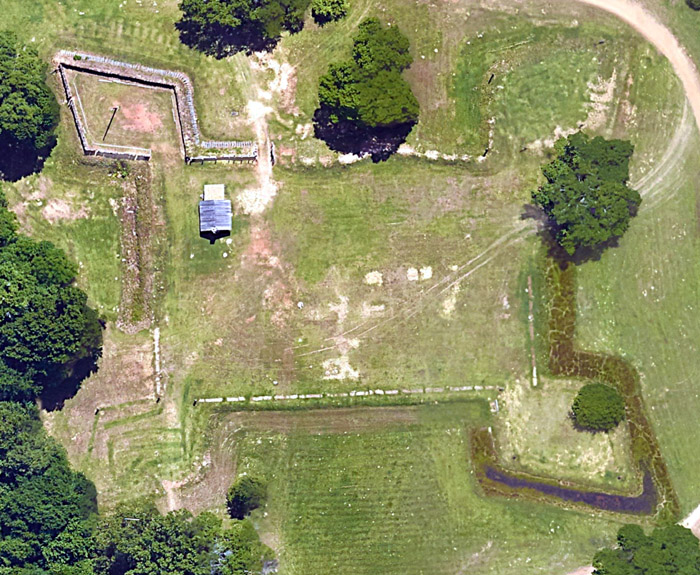 (this is Fort Jackson, which is not to be confused with Fort Jackson) (this is Fort Jackson, which is not to be confused with Fort Jackson) |
 |
Toulouse Constructed: 1717, 1751
Used by: France
Conflicts in which it participated:
None
Also known as: Franca choka chula,
Fort des Alibamons
Jackson Constructed: 1814
Used by: USA
Conflicts in which it participated:
Creek War/War of 1812
|
|
 |
|
|
Characteristically, the English, who were in the process of developing those thirteen colonies on the east coast of the New World, took issue with the notoriously imprecise French territorial claim of Louisiana, or New France.
|
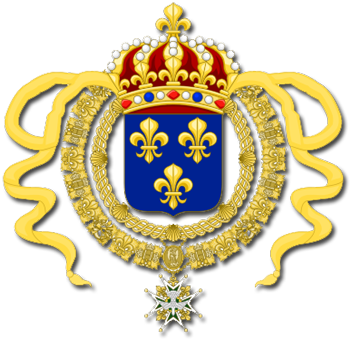 The device on the flag of New France for much of its existence, which, coincidentally, also happened to be King Louis XIV's royal standard. Those floofy tendrils on either side probably weren't intended to look like grasping tentacles, but... The device on the flag of New France for much of its existence, which, coincidentally, also happened to be King Louis XIV's royal standard. Those floofy tendrils on either side probably weren't intended to look like grasping tentacles, but... |
 |
Britain's colonies of Georgia and Carolina were encroaching into Louisiana by the start of the 18th century, and say what you want about Frenchmen, but they seldom passed up an opportunity to oppose the British! A fort was planned to protect the confluence of the Coosa and Tallapoosa Rivers (forming the Alabama River), which waterways sound ridiculous, but navigable waterways were the highways of the era.
The fort was named for Louis Alexandre, Comte de Toulouse (1678-1737), illegitimate son of the Sun King himself, France's King Louis XIV (1638-1715). It seems unlikely that Fort Toulouse's namesake was even aware that a little wooden starfort in the New World bore his name, but it never hurt to attempt to flatter royal persons.
Our wee fort was built on what was considered to be the eastern border of Louisiana. One of the reasons the French chose to place Fort Toulouse where they did was to get an aggressive local Indian tribe, the Alabama, into their sphere of influence and hopefully on their side against the British. |
|
Our fort was thus also known as Fort des Alibamons, a name whose meaning is obvious - but also by the Muscogee Indians as Franca choka chula, which is slightly less obvious, but which probably referred to how delicious French people were, with their native garlic seasoning.
|
The first Fort Toulouse was built with material and labor provided by those Alabamas, and was a four-pointed log palisade fort that mounted three or four swivel guns at its bastions. It was pretty shrimpy, less than 150 feet from bastion to bastion, but it was big enough to be the home of 20 to 50 French soldiers and Marines, plus around a hundred traders. These Frenchmen traded with the local community and got on well with their neighbors: This post was more about making Indians like the French than defending against the British, who likely never laid eyes on Fort Toulouse until it was their property after the Seven Years' War.
The Indians were content with the Frenchmen in their midst, but most of those Frenchmen were less so: In 1722 around two-thirds of Fort Toulouse's garrison mutinied, due to poor living conditions.
|
 |
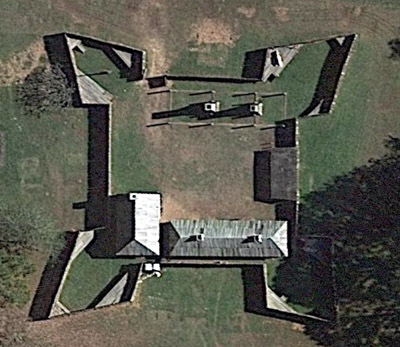 The Fort Toulouse that graces us with its presence today is a reproduction of the second iteration of the fort, which was built in 1751. The Fort Toulouse that graces us with its presence today is a reproduction of the second iteration of the fort, which was built in 1751. |
|
The mutineers killed the fort's commander, Captain Jean Baptiste Louis DeCourtel Marchand, who had married the daughter of a Creek Indian chief in 1720. They then tied up the fort's officers and melted into the woods. The local Indians were on the side of French authority, however - they rounded up the mutineers and turned them over to those authorities, who marched them to the major French outpost of Fort Condé in Mobile for punishment.
|
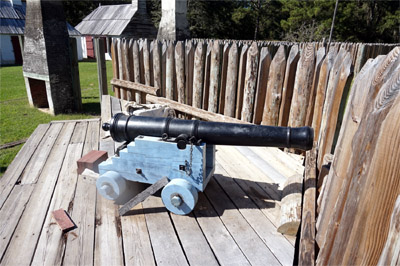 A naval gun, ready to loudly vanquish any British attacker, in one of Fort Toulouse's bastions. A naval gun, ready to loudly vanquish any British attacker, in one of Fort Toulouse's bastions. |
 |
Conditions improved for Fort Toulouse's garrison in the 1740's, with many soldiers marrying local and/or imported ladies, and the development of nearby farms which supplied decent food. By the end of the 1740's, the fort itself was disintegrating: Humidity, erosion and flooding had done what one might expect, and it was realized that the fort had been built too close to the river.
Fort Toulouse version 2.0 was built about 100 feet to the south in 1751, again with Alabama labor...even with what one assumes was free labor, the new fort cost 30,000 livres, which was over half the budget for fortifications in all of Louisiana for 1751. |
|
Just when France had things all nice and tidy at Fort Toulouse, they had to leave. The Seven Years' War (1756-1763), known on this side of the Atlantic as the French and Indian War, had not gone well for France. 1763's Treaty of Paris gave the Canadian part of New France and Florida to England, which gave it control of all of the continent east of the Mississippi River...and Louisiana went to Spain. Fort Toulouse's garrison spiked its guns and woefully marched to New Orleans in January of 1764. A British column led by a Captain Robertson visited our fort soon thereafter, sniffed in a depreciating fashion and pointedly did not opt to occupy it...likely a wise decision, as all the surrounding Indians were parital to the French. The Alabamas moved their village of Taskigi to the site...which pretty much concludes the story of Fort Toulouse, at least until its reconstruction follies of the 1970's.
|
|
|
 |
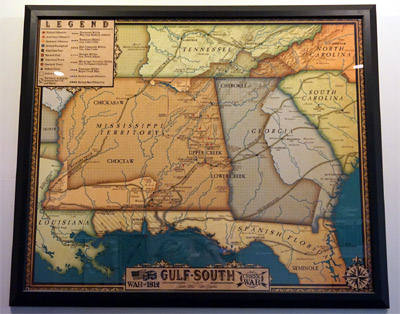 A pretty comprehensive representation of the War of 1812 in the southern territories and along the gulf, courtesy of Fort Toulouse/Fort Jackson's Visitor's Center and wee museum! A pretty comprehensive representation of the War of 1812 in the southern territories and along the gulf, courtesy of Fort Toulouse/Fort Jackson's Visitor's Center and wee museum! |
|
Having defeated and mostly wiped out the dreaded Red Stick Creek Indians at the Battle of Horseshoe Bend (March 27, 1814), Jackson and his regular troops and militia showed up at what was left of Fort Toulouse in May of 1814. Little other than the old French fort's moat outline was left, but Jackson recognized a strategic spot when he saw one, and a fort in his name was built atop Fort Toulouse's remains.
|
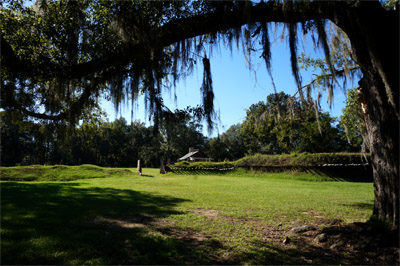 The entrance to Fort Jackson today, from under a really quite picturesque live oak tree. The entrance to Fort Jackson today, from under a really quite picturesque live oak tree. |
 |
Fort Jackson was an earthwork fort, with walls that were seven feet high and picketed, meaning that there were pointy sticks jutting menacingly out from its walls and bastions, all of which was surrounded by the standard moat.
Carolina militia labor was used to build the fort, as the Americans hadn't learned the trick of befriending local Indians and convincing them to do all the work, which had been the specialty of the French.
Just a few weeks after Jackson had established his eponymous starfort, whom should present himself for surrender but William Weatherford (1781-1824). |
|
A Creek Indian who had led the Red Sticks but escaped after the Battle of Horseshoe Bend, Weatherford agreed to help Jackson persuade the remaining belligerent Indians to see reason and accept the Great White Father (President James Madison (1751-1836))'s wishes, as presented by the Great White Father's Most Holy Representative on Earth, Andrew Jackson.
|
With Weatherford's help, Jackson managed to get the Creek authorities to sign the Treaty of Fort Jackson on August 9, 1814. In this treaty the Creek agreed to surrender 23 million acres of their territory to the United States, which included about a fifth of what is today Georgia, and just about all of central Alabama. What did the Creek get out of this treaty? What an interesting question.
Peace with the Creeks having been accomplished in a satisfactory fashion, Jackson was now free to make his way to Louisiana, where he would assure his place in history (and his future presidency) by whupping up an unlikely defensive conglomeration of soldiers, sailors, Indians, militia, townspersons, pirates and barnyard animals which defeated the British at the Battle of New Orleans in January of 1815, effectively ending the War of 1812. Viva Jackson!
|
 |
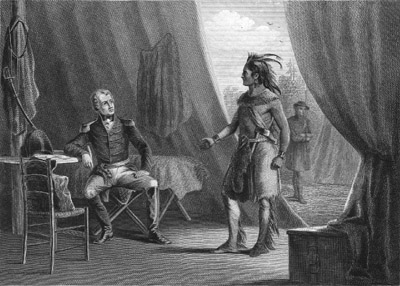 Jackson and Weatherford, an 1859 (or so) engraving by John Reuben Chapin (1823-1894) of William Weatherford surrendering himself in a dignified manner at Fort Jackson. Jackson and Weatherford, an 1859 (or so) engraving by John Reuben Chapin (1823-1894) of William Weatherford surrendering himself in a dignified manner at Fort Jackson. |
|
Jackson & co. made their victorious return to Fort Jackson, but the man himself was on to bigger and better things, such as making up a pretext to invade Florida - which was Spanish territory - and nabbing Pensacola from them in 1818. Which gives me an excellent opportunity to namedrop Fort Barrancas.
|
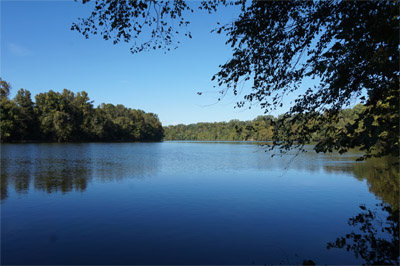 The reason for the fortin': The Coosa River at Fort Jackson. The reason for the fortin': The Coosa River at Fort Jackson. |
 |
Fort Jackson was manned by the US Army until 1817, when the small settlement near the fort picked itself up and moved south to what is now the city of Montgomery. Our fort was abandoned, by the army, but a well-built fort is a useful thing to have around, especially when you have some folks you want to imprison.
Fort Jackson's brig served as the first prison for Montgomery County's seat at Fort Jackson Town for two years, until the town of Montgomery was set up as the county seat. At last everybody left Fort Jackson in 1819, and it was allowed to peacefully disintegrate for the next century & a half. |
|
The leadup to America's bicentennial in 1976 brought with it a renewed interest in historic American things. Several of these things were starforts, and a sudden mania for fort reconstruction burst across the land, ahead of a hoped-for wave of tourism: Fort Roberdeau in Pennsylvania and Fort Meigs in Ohio are two forts that were rebuilt in this period...as was Fort Toulouse! Sort of!
|
In a frantic spurt of bicentennial fervor, local groups paid for the reconstruction Fort Toulouse in time for visitors of the magical year 1976...only they built it based on the remaining outline of the much larger Fort Jackson. Wrong!
I'm certainly not one to fault an enthusiasm for historic starfort reconstruction, and one can only imagine the difficulties involved in interpreting the ragged remains of a fort that's been rotting for 150 years. Plus, imagine the agony of the guy who's realized that this massive undertaking is demonstrably incorrect, and must be corrected for the sake of history.
|
 |
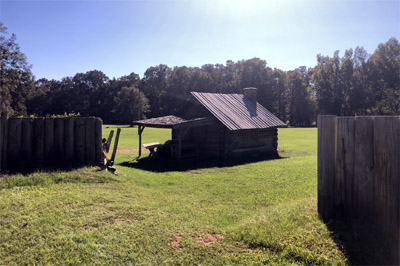 The only structure in Fort Jackson today is this fetchingly dilapidated log cabin, as seen here from the fort's northeast bastion. The only structure in Fort Jackson today is this fetchingly dilapidated log cabin, as seen here from the fort's northeast bastion. |
|
Fortunately, the Alabama Historical Commission took possession of the fort and its immediate environs in the 1980's, razed the incorrect fort and reconstructed Fort Toulouse at its proper dimensions about a quarter mile to the northeast of its original location.
|
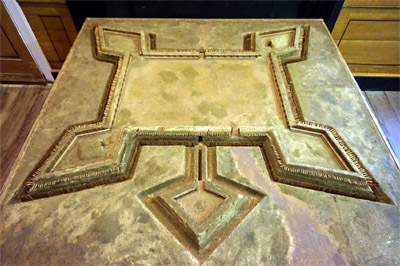 A beautiful semidiorama of Fort Jackson in the park's Visitor's Center/Museum/Shoppe. A beautiful semidiorama of Fort Jackson in the park's Visitor's Center/Museum/Shoppe. |
 |
Fort Jackson's reconstruction appears to be an ongoing effort: When I visited Fort Toulouse-Fort Jackson State Historic Site in 2018, Fort Toulouse was a lovely little wooden starfort with plenty of cool interior buildings, and Fort Jackson was a single reconstructed bastion and a log cabin, with the rest of the fort's walls represented with varying levels of seriousness: The northwest bastion is marked off with a series of stakes, but the moat around the southwest bastion looks as though it might actually hold some water under the right conditions.
In case you haven't already figured it out, I visited Fort Toulouse/Fort Jackson State Historic Site in 2018! |
|
If you haven't had your fill of these starforts yet, you can visit the gallery of pix I took there here, in the Starforts I've Visited section. At the time of this writing, I have not actually put that gallery together yet, but sometime within the next three years or so, it's sure to happen.
|
|
|
|
|
|
 |




